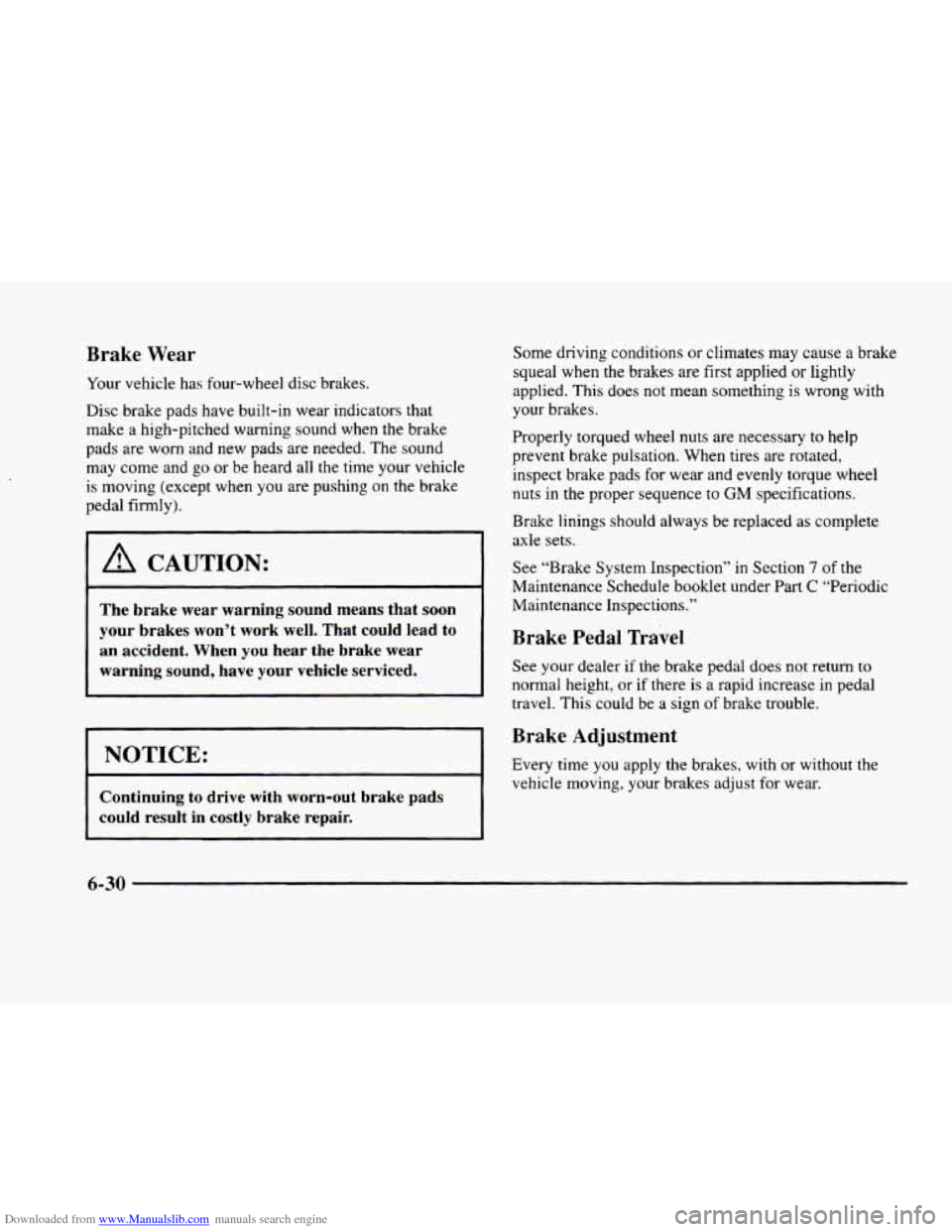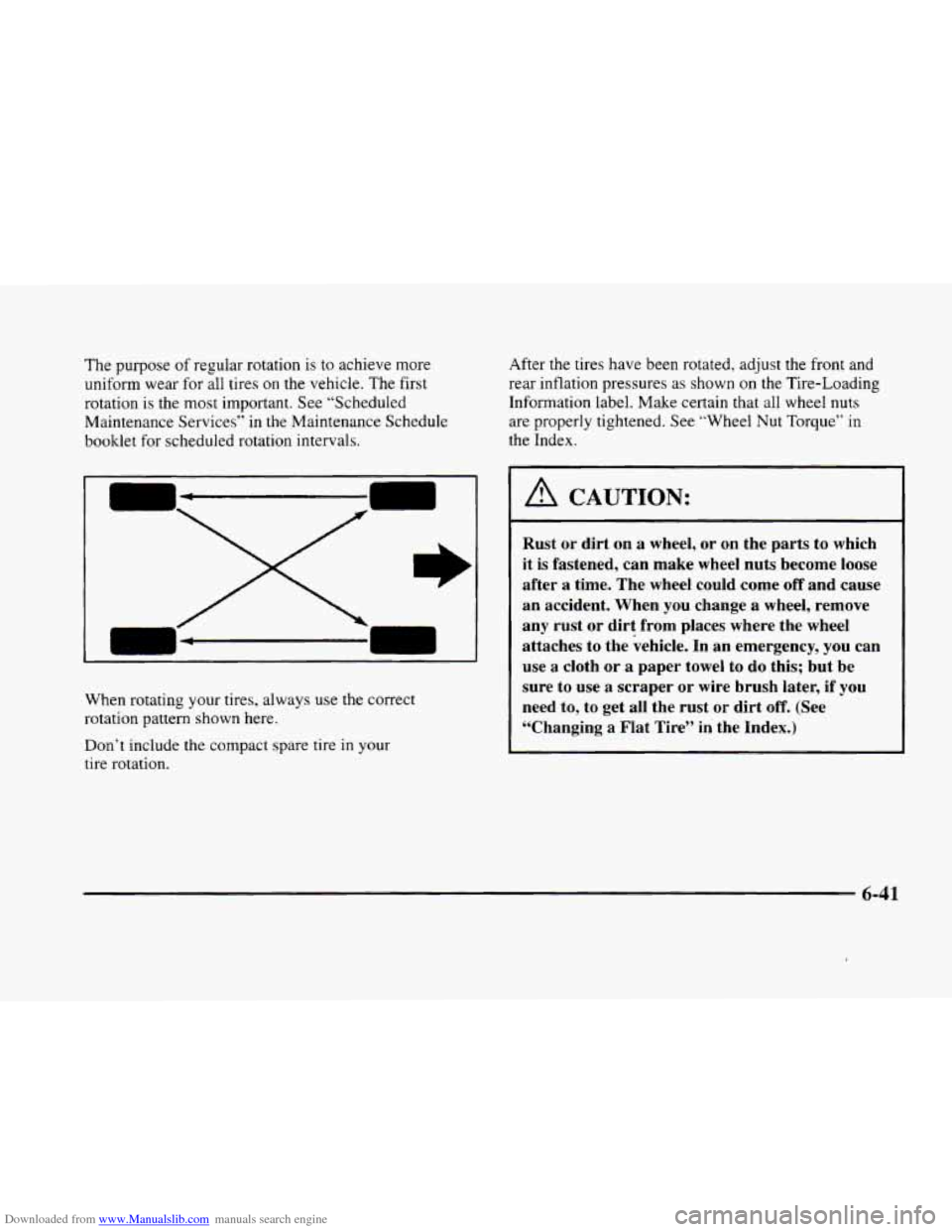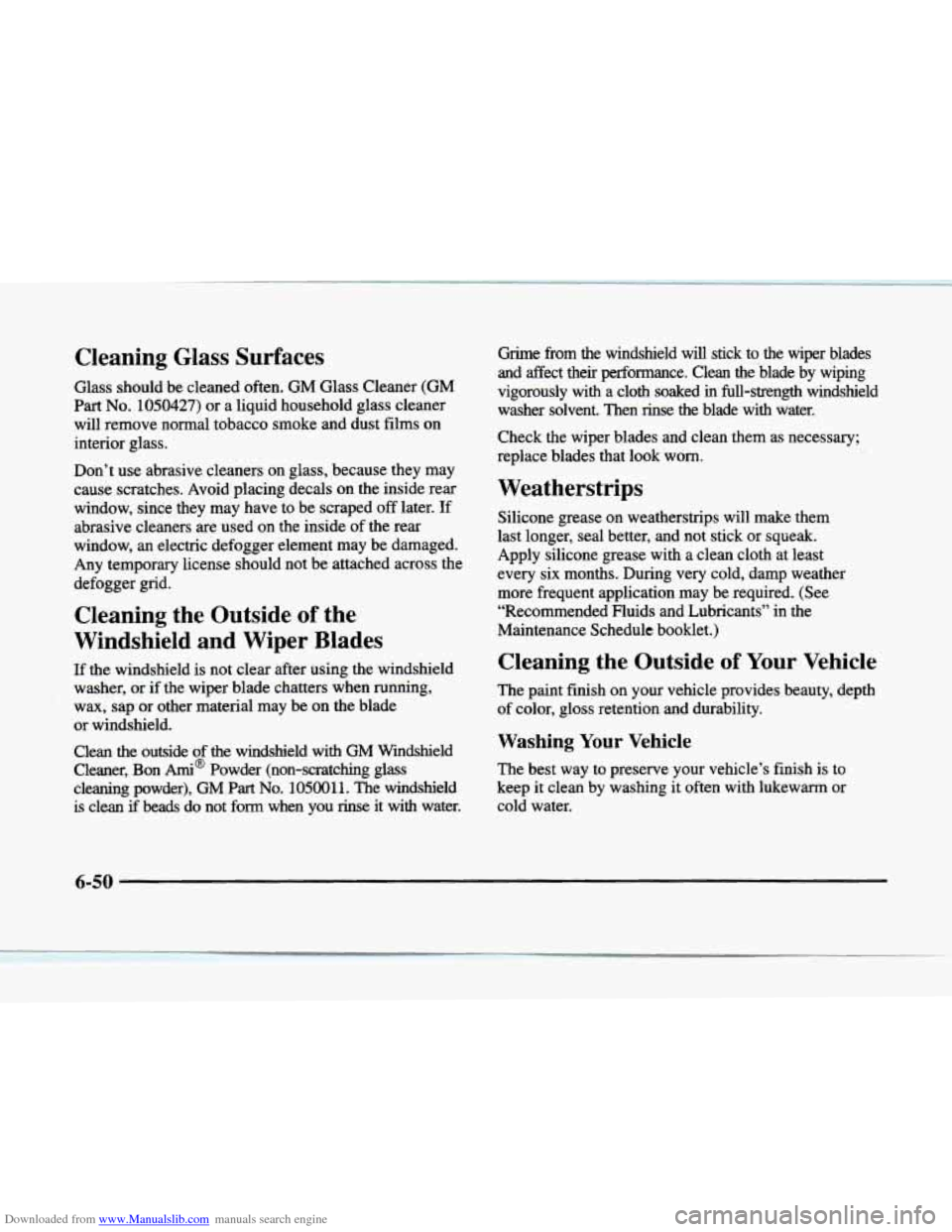1998 CADILLAC ELDORADO maintenance schedule
[x] Cancel search: maintenance schedulePage 306 of 380

Downloaded from www.Manualslib.com manuals search engine Power Steering Fluid
c
The power steering fluid
reservoir
is located next
to the coolant surge tank
on the passenger’s side
When to Check Power Steering Fluid
It is not necessary to regularly check power steering
fluid unless you suspect there is
a leak in the system or
you hear an unusual noise.
A fluid loss in this system
could indicate a problem. Have the system inspected
and repaired.
How To Check Power Steering Fluid
When the engine compartment is cool, wipe the cap and
the top of
the reservoir clean, then unscrew the cap and
wipe the dipstick with a clean rag. Replace the cap and
completely tighten
it. Then remove the cap again and
look at the fluid level on the dipstick.
The level should be at the
FULL COLD mark. If
necessary, add
only enough fluid to bring the level up
to the mark.
What to Use
To determine what kind of fluid to use, see
“Recommended Fluids and Lubricants” in the
Maintenance Schedule booklet. Always use the
proper fluid. Failure to use the proper fluid can cause
leaks and damage
hoses and seals,
Windshield Washer Fluid
What to Use
When you need windshield washer fluid, be sure to read
the manufacturer’s instructions before use.
if you will be
operating your vehicle in an area where the temperature
may fall below freezing, use a fluid that has sufficient
protection against freezing.
6-26
Page 310 of 380

Downloaded from www.Manualslib.com manuals search engine Brake Wear
Your vehicle has four-wheel disc brakes.
Disc brake pads have built-in wear indicators that
make a high-pitched warning sound when the brake
pads are worn and new pads are needed. The sound
may come and go or be heard all the time your vehicle
is moving (except when you are pushing on the brake
pedal firmly).
I A CAUTION:
The brake wear warning sound means that soon
your brakes won’t work well. That could lead to
an accident, When you hear the brake wear
warning sound, have your vehicle serviced.
NOTICE:
Continuing to drive with worn-out brake pads
could result
in costly brake repair.
Some driving conditions or climates may cause a brake
squeal when the brakes
are first applied or lightly
applied. This does not mean something is wrong with
your brakes.
Properly torqued wheel nuts are necessary
to help
prevent brake pulsation. When tires are rotated,
inspect brake pads for wear and evenly torque wheel
nuts
in the proper sequence to GM specifications.
Brake linings should always be replaced as complete
axle sets.
See “Brake System Inspection”
in Section 7 of the
Maintenance Schedule booklet under Part
C “Periodic
Maintenance Inspections.”
Brake Pedal Travel
See your dealer if the brake pedal does not return to
normal height, or if there is a rapid increase in pedal
travel. This could be a sign of brake trouble.
Brake Adjustment
Every time you apply the brakes, with or without the
vehicle moving, your brakes adjust for wear.
6-30
Page 321 of 380

Downloaded from www.Manualslib.com manuals search engine The purpose of regular rotation is to achieve more
uniform wear for all tires
on the vehicle. The first
rotation is
the most important. See “Scheduled
Maintenance Services” in
the Maintenance Schedule
booklet for scheduled rotation intervals.
When rotating your tires, always
use the correct
rotation pattern shown here.
Don’t include the compact spare tire
in your
tire rotation. After the tires have been rotated,
adjust
the front and
rear inflation pressures as shown
on the Tire-Loading
Information label. Make certain that all wheel nuts
are properly tightened. See “Wheel Nut Torque” in
the Index.
I A CAUTION:
Rust or dirt on a wheel, or on the parts to which
it
is fastened, can make wheel nuts become loose
after a time. The wheel could come
off and cause
an accident. When you change
a wheel, remove
any rust or dirt from places where the wheel
attaches to the vehicle.
In an emergency, you can
use a cloth or a paper towel
to do this; but be
sure to use a scraper or wire brush later, if you
need to, to get all the rust or dirt
off. (See
“Changing a Flat Tire” in the Index.)
6-41
Page 330 of 380

Downloaded from www.Manualslib.com manuals search engine Cleaning Glass Surfaces
Glass should be cleaned often. GM Glass Cleaner (GM
Part No. 1050427) or a liquid household glass cleaner
will remove normal tobacco smoke and dust films on
interior glass.
Don’t use abrasive cleaners on glass, because they may
cause scratches. Avoid placing decals on the inside rear
window, since they may have to be scraped
off later. If
abrasive cleaners are used on the inside of the rear
window, an electric defogger element may be damaged.
Any temporary license should not be attached across the
defogger grid.
Cleaning the Outside of the
Windshield and Wiper Blades
If the windshield is not clear after using the windshield
washer,
or if the wiper blade chatters when running,
wax, sap or other material may be
on the blade
or windshield.
Clean the outside of
the windshield with GM Windshield
Cleaner, Bon
Ami@ Powder (non-scratching glass
cleaning powder),
GM Part No. 105001.1. The windshield
is clean
if beads do not form when you rinse it with water. Grime from
the windshield
will stick to the wiper blades
and atfat their performance. Clean the blade
by wiping
vigorously
with a cloth soaked in full-strength windshield
washer solvent. Then rinse the blade with water.
Check the wiper blades and clean them as necessary;
replace blades that look worn.
Weatherstrips
Silicone grease on weatherstrips will make them
last longer, seal better, and not stick or squeak.
Apply silicone grease with a clean cloth at least
every six months. During very cold, damp weather
more frequent application may be required. (See
“Recommended Fluids and Lubricants” in the
Maintenance Schedule booklet.)
Cleaning the Outside of Your Vehicle
The paint finish on your vehicle provides beauty, depth
of color, gloss retention and durability.
Washing Your Vehicle
The best way to preserve your vehicle’s finish is to
keep it clean by washing it often
with lukewarm or
cold water.
6-50
1
f
Page 360 of 380

Downloaded from www.Manualslib.com manuals search engine 1998 CADILLAC SERVICE PUBLICATIONS ORDERING INFORMATION
The following publications covering the operation and servicing of your vehicle can be purchased by filling oui
the Service Publication Order Form in this book and mailing it in with your check, money order,
or credit card information to Helm, Incorporated (address below.)
CURRENT PUBLICATIONS FOR 1998 CADILLAC
SERVICE MANUALS
Service Manuals have the diagnosis and repair information
on engines, transmission, axle, suspension, brakes,
electrical, steering, body, etc.
RETAIL SELL
PRICE: $90.00
TRANSMISSION, TRANSAXLE, TRANSFER CASE UNIT REPAIR MANUAL
This manual provides information on unit repair service
procedures, adjustments and specifications for the
1998 GM transmissions, transaxles and transfer cases.
RETAIL
SELL PRICE: $40.00
SERVICE BULLETINS
Service Bulletins give technical service information needed
to knowledgeably service General Motors cars and trucks.
Each bulletin contains instructions to assist
in the
diagnosis and service of your vehicle.
PLEASE COMPLETE THE ORDER FORM SHOWN ON
THE FOLLOWING PAGE AND MAIL TO:
Helm, Incorporated P.O. Box 07130 Detroit, MI 48207
OWNER’S INFORMATION
Owner publications are written directly for Owners and
intended to provide basic operational information about the
vehicle. The owner’s manual will include the Maintenance
Schedule for
all models.
In-Portfolio: Includes a
Portfolio, Owner’s Manual and
Warranty Booklet. RETAIL SELL PRICE:
$1 5.00
Without Portfolio: Owner’s Manual only.
RETAIL SELL PRICE:
$1 0.00
CURRENT & PAST MODEL ORDER FORMS
Service Publications are available for current and past
model GM vehicles.
To request an order form, please
specify year and model name of the vehicle.
OR ORDER TOLL FREE: 1-800-782-4356
Monday-Friday 8:OO AM - 6:OO PM Eastern Time
For Credit Card Orders Only
(VISA-MasterCarcCDiscover)